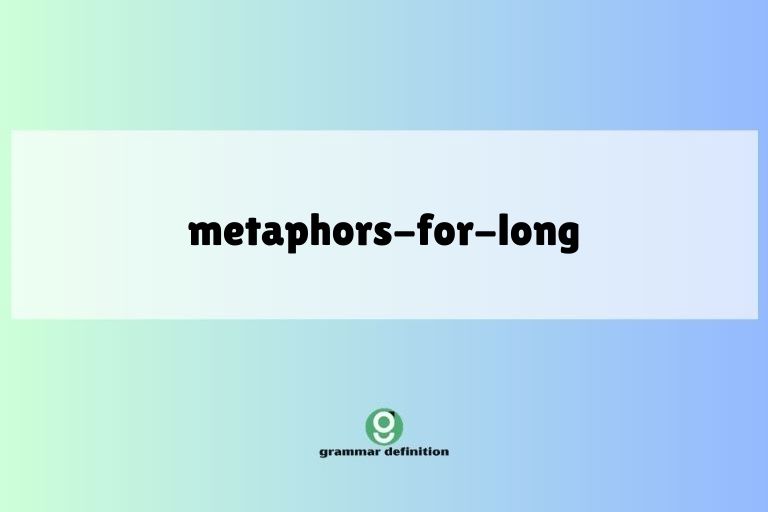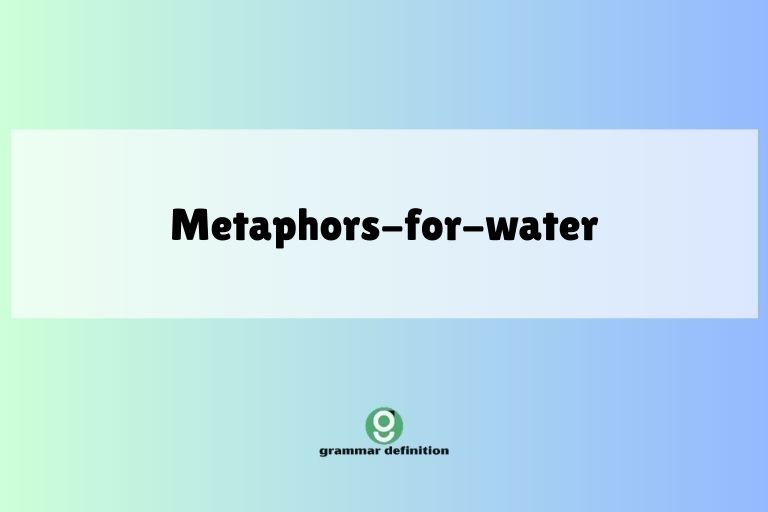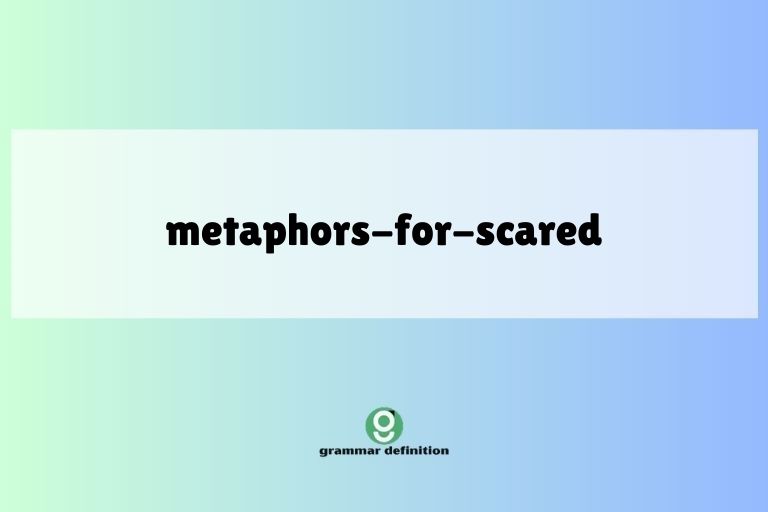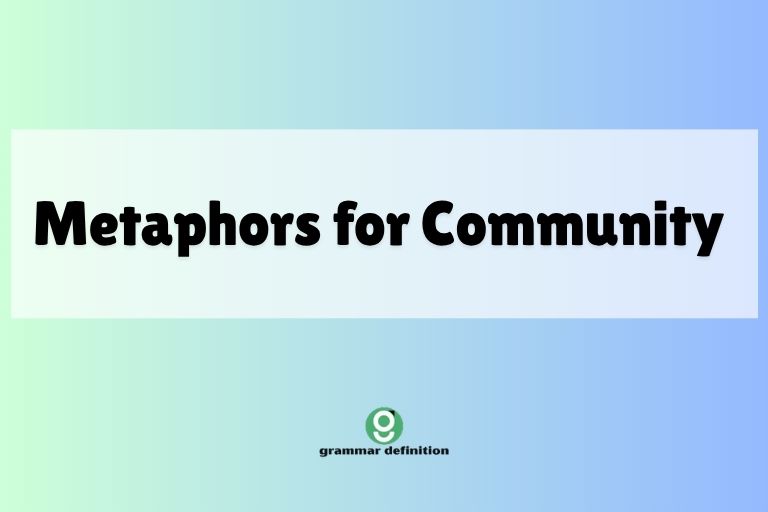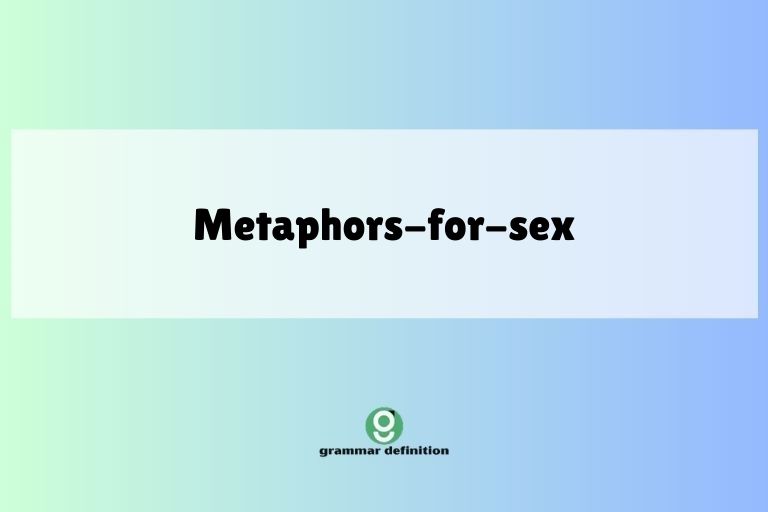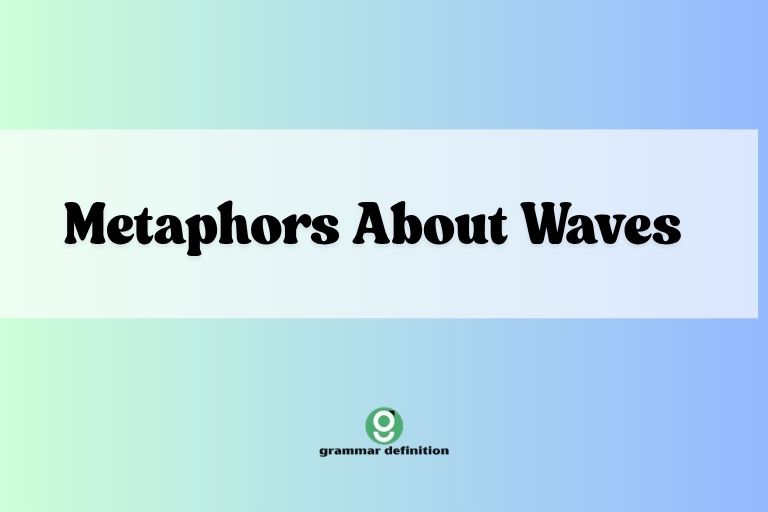Seashore Similes: Mastering Beach Metaphors in English
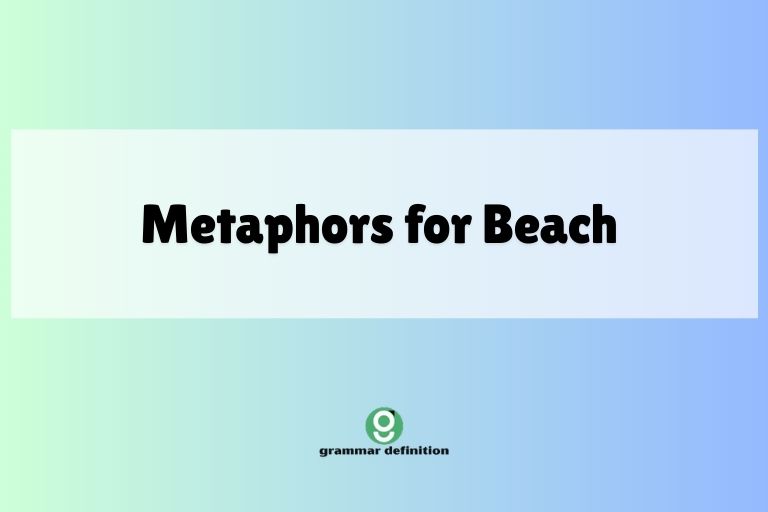
Metaphors are powerful tools in the English language, allowing us to convey complex ideas and emotions by comparing them to something else. Understanding and using metaphors effectively can significantly enhance your communication skills, making your writing and speech more vivid and engaging.
This article delves into the world of metaphors specifically related to the beach, exploring how they are structured, how to use them correctly, and how to avoid common pitfalls. Whether you’re a beginner or an advanced learner, this comprehensive guide will equip you with the knowledge and skills to master beach metaphors and enrich your language.
This guide is designed for English language learners of all levels, from beginners looking to expand their vocabulary to advanced speakers aiming to refine their expressive abilities. Native English speakers can also benefit from this structured exploration of a specific metaphorical domain.
By the end of this article, you’ll have a deeper appreciation for the nuances of metaphorical language and the ability to use beach-related metaphors with confidence and creativity.
Table of Contents
- Introduction
- Definition of Metaphor
- Structural Breakdown of Beach Metaphors
- Types of Beach Metaphors
- Examples of Beach Metaphors
- Usage Rules for Beach Metaphors
- Common Mistakes with Beach Metaphors
- Practice Exercises
- Advanced Topics
- FAQ: Frequently Asked Questions
- Conclusion
Definition of Metaphor
A metaphor is a figure of speech that directly compares two unlike things without using “like” or “as.” It asserts that one thing *is* another, implying a similarity or shared quality between them. This comparison is not literal but imaginative, designed to create a vivid image or convey a deeper meaning.
Metaphors are essential for enriching language, making it more expressive and engaging. They allow us to understand abstract concepts in more concrete terms.
In essence, a metaphor transfers qualities from one thing (the source) to another (the target). For example, saying “He is a lion in battle” doesn’t mean he’s literally a lion, but that he possesses the lion’s qualities of courage and strength.
The power of a metaphor lies in its ability to evoke emotions and create a deeper understanding than a literal statement could achieve.
Metaphors are classified as figures of speech, specifically those that rely on implicit comparison. Their function is primarily to enhance communication by adding layers of meaning and emotional impact.
They are used in various contexts, including literature, everyday conversation, and persuasive writing. The effectiveness of a metaphor depends on the audience’s ability to recognize the implied comparison and understand the shared qualities between the source and the target.
Structural Breakdown of Beach Metaphors
Understanding the structure of beach metaphors involves recognizing the two key elements: the tenor and the vehicle. The tenor is the subject being described, while the vehicle is the beach-related element used to describe it. The connection between the tenor and the vehicle is the implied similarity, the shared quality that makes the metaphor work. Identifying these components helps in both understanding and creating effective metaphors.
For instance, in the metaphor “Her sadness was a vast, empty beach,” the tenor is “her sadness,” and the vehicle is “a vast, empty beach.” The implied similarity is the feeling of emptiness, loneliness, and desolation that both sadness and a deserted beach can evoke. The effectiveness of this metaphor lies in the reader’s ability to connect these two seemingly disparate concepts through their shared emotional impact.
The structure also includes the ground, which refers to the shared characteristics or qualities between the tenor and the vehicle. In the example above, the ground is the feeling of emptiness and desolation. Recognizing the ground is crucial for ensuring that the metaphor is clear and understandable. A well-constructed metaphor will have a clear and easily identifiable ground, making the comparison both meaningful and impactful.
Types of Beach Metaphors
Beach metaphors can be categorized based on the aspects of life or experience they represent. Here are some common categories:
Emotional States
These metaphors use beach imagery to describe feelings and emotions. The vastness of the ocean, the tranquility of the shore, or the turbulence of a storm can all represent different emotional states.
Life’s Journey
The beach can symbolize the journey of life, with the shoreline representing the present, the ocean representing the future, and the sand representing the passage of time. These metaphors often explore themes of change, growth, and destiny.
Personal Qualities
Certain characteristics of the beach, such as its strength, resilience, or beauty, can be used to describe personal qualities. Someone might be described as “grounded like the shore” to indicate stability and reliability.
Challenges and Opportunities
The unpredictable nature of the sea and the challenges of navigating the shoreline can represent life’s obstacles and the opportunities that arise from overcoming them. A “stormy sea” might symbolize a difficult period, while a “calm tide” could represent a time of ease and progress.
Time and Change
The constant ebb and flow of the tide, the erosion of the shoreline, and the changing seasons can all represent the passage of time and the inevitability of change. These metaphors often explore themes of impermanence, transformation, and renewal.
Examples of Beach Metaphors
Here are some examples of beach metaphors, categorized by the types discussed above. These examples illustrate how beach imagery can be used to convey a wide range of meanings and emotions.
Emotional State Examples
The following table provides examples of metaphors that use beach imagery to describe emotional states. Each example includes the metaphor, the implied meaning, and an explanation of the connection between the tenor and the vehicle.
These examples demonstrate the versatility of beach metaphors in expressing a wide range of emotions.
| Metaphor | Implied Meaning | Explanation |
|---|---|---|
| Her sadness was a vast, empty beach. | Loneliness and desolation | The emptiness of the beach mirrors the feeling of sadness. |
| His joy was a sunny day at the beach. | Happiness and contentment | The warmth and brightness of a sunny day represent joy. |
| Anxiety washed over her like a relentless tide. | Overwhelming worry | The constant, unstoppable nature of the tide represents anxiety. |
| Peace settled on him like a gentle sea breeze. | Calm and tranquility | The soothing nature of the breeze represents peace. |
| Her anger was a stormy sea, crashing against the shore. | Intense rage and frustration | The violence and turbulence of a storm represent anger. |
| He felt adrift, like a lone seashell on the sand. | Feeling lost and isolated | The isolation of a single shell mirrors the feeling of being adrift. |
| Her hope was a lighthouse, guiding him through the fog. | A source of guidance and optimism | The lighthouse provides direction and hope in difficult times. |
| His memories were like sea glass, smoothed and softened by time. | Nostalgia and reflection | The softened edges of sea glass represent the passage of time and fond memories. |
| Her heart was a seashell, delicate and easily broken. | Vulnerability and fragility | The delicate nature of a seashell represents emotional vulnerability. |
| His fear was a dark ocean, full of unknown dangers. | Apprehension and uncertainty | The unknown depths of the ocean represent fear and uncertainty. |
| She felt grounded, like the sturdy cliffs overlooking the sea. | Stability and strength | The unwavering nature of the cliffs represents emotional stability. |
| His disappointment was a low tide, revealing hidden rocks. | Unpleasant truths | The revealing of hidden rocks represents the uncovering of unpleasant truths. |
| Her excitement bubbled like the foam of the waves. | Enthusiasm and anticipation | The effervescent nature of foam represents excitement. |
| Loneliness echoed around her like the call of a distant gull. | Isolation and longing | The solitary call of a gull represents the feeling of being alone. |
| His regret was a heavy anchor, dragging him down. | Guilt and remorse | The weight of an anchor represents the burden of regret. |
| Her love was a warm current, carrying him along. | Support and affection | The gentle flow of a current represents love and support. |
| His confusion was a dense fog rolling in from the sea. | Uncertainty and disorientation | The obscuring nature of fog represents confusion. |
| She felt exposed, like a sandcastle at high tide. | Vulnerability and risk | The vulnerability of a sandcastle to the tide represents exposure. |
| His determination was a steady wind, pushing him forward. | Motivation and perseverance | The constant force of the wind represents determination. |
| Her hope flickered like a candle in the sea breeze. | Fragile optimism | The easily extinguished candle represents fragile hope. |
| His despair was a shipwreck, lost beneath the waves. | Overwhelming sadness and ruin | The complete loss of a shipwreck represents despair. |
Life’s Journey Examples
This table provides examples of metaphors that use beach imagery to describe the journey of life. These metaphors often focus on themes of progress, challenges, and the passage of time.
Understanding these metaphors can provide a deeper appreciation for the complexities of life’s journey.
| Metaphor | Implied Meaning | Explanation |
|---|---|---|
| Life is a beach, enjoy the waves. | Embrace the ups and downs of life. | The waves represent the challenges and joys of life. |
| Her life was a long walk on the beach. | A journey with its own pace and direction | The walk represents the journey, the beach the path of life. |
| Navigating life is like sailing through a stormy sea. | Life involves overcoming challenges and obstacles. | The stormy sea represents the difficulties encountered in life. |
| He’s reached the shore of retirement after a long voyage. | The end of a career and the beginning of a new phase. | The shore represents the end, the voyage the career. |
| Life’s challenges are like a high tide, they eventually recede. | Difficult times are temporary and will pass. | The receding tide represents the end of the challenges. |
| The sands of time are constantly shifting beneath our feet. | Time is always moving forward, and things are always changing. | Shifting sands represent the continuous passage of time. |
| Her career path was a winding coastline. | An unpredictable journey with many twists and turns. | The winding coastline represents the unpredictable path. |
| He weathered the storm of his youth and found calmer waters. | Overcoming the challenges of youth leads to a more peaceful life. | The storm represents the challenges, the calmer waters the peace. |
| Life is a collection of seashells, each representing a memory. | Memories are valuable and cherished moments in life. | Seashells represent the memories collected over time. |
| The future stretches before us like an endless ocean. | The possibilities and uncertainties of the future. | The ocean represents the vast and unknown future. |
| She built her life on solid ground, like a lighthouse on a cliff. | A stable and secure foundation for life. | The lighthouse represents the strength and stability. |
| His dreams were ships sailing towards distant horizons. | Aspirations and goals for the future. | The ships represent the dreams, the horizons the goals. |
| Life’s journey is like a beachcomber’s search for treasures. | The pursuit of happiness and fulfillment. | The search represents the journey, the treasures the fulfillment. |
| He found his peace in the rhythm of the waves. | Finding comfort and stability in life’s natural flow. | The rhythm represents the natural flow, the peace the comfort. |
| Her wisdom was like the ancient cliffs, weathered by time. | Knowledge and experience gained over a lifetime. | The cliffs represent the knowledge, the weathering the experience. |
| Life is a sandcastle, beautiful but temporary. | The transient nature of life and its creations. | The sandcastle represents the beauty, the temporary nature the fleeting aspect of life. |
| He learned to navigate the currents of life’s challenges. | Developing the skills to overcome obstacles. | The currents represent the challenges, the navigation the skills. |
| Her spirit was as boundless as the open sea. | Limitless potential and freedom. | The sea represents the potential, the openness the freedom. |
| Life is a beach fire, warm and inviting but eventually fades. | The warmth and joy of life are temporary. | The fire represents the warmth, the fading the temporary nature. |
| He left his footprints in the sands of time. | Making a lasting impact on the world. | The footprints represent the impact, the sands the passage of time. |
| Her future sparkled like sunlight on the water. | A bright and promising future. | The sunlight represents the promise, the sparkle the brightness. |
| The ebb and flow of life brought both joy and sorrow. | Life is a balance of positive and negative experiences. | The ebb and flow represent the balance, the joy and sorrow the experiences. |
| He built his life on shifting sands, without a solid foundation. | A life lacking stability and security. | The shifting sands represent the instability, the lack of foundation the insecurity. |
Personal Qualities Examples
This table provides examples of metaphors that use beach imagery to describe personal qualities. These metaphors highlight the strengths, weaknesses, and characteristics of individuals, using the beach as a metaphorical landscape.
| Metaphor | Implied Meaning | Explanation |
|---|---|---|
| She is as resilient as the shoreline. | Able to withstand hardship and bounce back from adversity. | The shoreline endures constant erosion and storms, representing resilience. |
| He is as grounded as the shore. | Stable, reliable, and dependable. | The shore provides a firm foundation, representing stability. |
| Her personality is as bright as a sunny beach. | Cheerful, optimistic, and welcoming. | The sunny beach evokes feelings of happiness and warmth. |
| He is as calm as a still sea. | Peaceful, serene, and composed. | A still sea represents tranquility and composure. |
| She is as mysterious as the deep ocean. | Intriguing, complex, and enigmatic. | The deep ocean holds unknown secrets, representing mystery. |
| He is as adaptable as seaweed in the tide. | Flexible, versatile, and able to adjust to changing circumstances. | Seaweed bends and flows with the tide, representing adaptability. |
| Her spirit is as free as a seagull soaring over the ocean. | Independent, uninhibited, and unrestrained. | The soaring seagull represents freedom and independence. |
| He is as strong as the cliffs overlooking the sea. | Resilient, unwavering, and steadfast. | Cliffs stand firm against the elements, representing strength. |
| She is as gentle as the soft sand beneath your feet. | Kind, compassionate, and comforting. | Soft sand provides a pleasant and soothing experience. |
| He is as unpredictable as the changing tides. | Erratic, inconsistent, and prone to sudden shifts. | The tides fluctuate constantly, representing unpredictability. |
| She is as radiant as the sunset over the sea. | Beautiful, glowing, and captivating. | The sunset evokes feelings of awe and admiration. |
| He is as persistent as the waves crashing on the shore. | Determined, relentless, and unwavering in pursuit of goals. | Waves continuously break on the shore, representing persistence. |
| She is as pure as the clear blue sea. | Innocent, untainted, and virtuous. | Clear blue sea represents purity and innocence. |
| He is as deep as the ocean trench. | Profound, thoughtful, and insightful. | Ocean trenches are the deepest parts of the ocean, a metaphor for profound thought. |
| She is as sparkling as the sunlight on the waves. | Vivacious, lively, and full of energy. | Sunlight reflecting on the waves creates a shimmering effect. |
| He is as patient as a fisherman waiting for a catch. | Tolerant, enduring, and willing to wait for results. | Fishermen must wait patiently for their catch, representing patience. |
| She is as nurturing as the sea providing life to its creatures. | Caring, supportive, and providing for others. | The sea sustains life for countless creatures, representing nurture. |
| He is as steady as a ship sailing on calm waters. | Reliable, consistent, and stable in character. | A ship on calm waters moves smoothly and predictably. |
| She is as wild as the untamed ocean. | Unrestrained, free-spirited, and passionate. | The untamed ocean is a force of nature, representing wildness. |
| He is as adaptable as a beach plant surviving in harsh conditions. | Resourceful, resilient, and able to thrive in difficult environments. | Beach plants adapt to survive in harsh conditions, representing adaptability. |
| She is as radiant as the moon reflecting on the sea. | Beautiful, elegant, and ethereal. | The moon reflecting on the sea creates a serene image. |
| He is as wise as the ancient mariners who navigated by the stars. | Knowledgeable, experienced, and insightful. | Ancient mariners used their knowledge of the stars to navigate, representing wisdom. |
| She is as transparent as clear seawater. | Honest, open, and straightforward in communication. | Clear seawater allows you to see through it, representing transparency. |
Challenges and Opportunities Examples
This table provides examples of metaphors that use beach imagery to describe challenges and opportunities. These metaphors illustrate how life’s difficulties and chances can be viewed through the lens of the beach environment.
| Metaphor | Implied Meaning | Explanation |
|---|---|---|
| The storm of challenges crashed against the shore of his resolve. | Difficulties testing his determination and strength. | The storm represents challenges, the shore his resolve. |
| Opportunities washed ashore like unexpected treasures. | Unexpected chances and beneficial circumstances. | Treasures washed ashore represent unexpected benefits. |
| Navigating the currents of change was a difficult voyage. | Adapting to new circumstances and overcoming obstacles. | Currents represent change, the voyage the navigation. |
| The path to success was a rocky beach, hard to traverse. | The journey to achievement is filled with difficulties and setbacks. | Rocky beach represents a difficult path to traverse. |
| He faced the rising tide of adversity with unwavering courage. | Confronting increasing challenges with bravery. | Rising tide represents increasing difficulties. |
| The fog of uncertainty clouded his judgment. | Confusion and lack of clarity hindering decision-making. | Fog represents confusion and lack of clarity. |
| He built his success on shifting sands of unstable foundations. | Achievement built on unreliable or precarious circumstances. | Shifting sands represent unstable foundations. |
| The waves of innovation crashed against the old ways. | Conflicts between new ideas and traditional methods. | Waves represent innovation, old ways represent traditional methods. |
| The sea of opportunity stretched before her, vast and unexplored. | Numerous possibilities and potential avenues to pursue. | The sea represents a vast area of opportunity. |
| He found himself adrift in a sea of doubt. | Feeling lost and uncertain in a situation. | The sea represents a state of uncertainty and confusion. |
| The lighthouse of guidance shone through the storm of confusion. | Clear direction and support amidst difficult times. | The lighthouse represents guidance and direction. |
| She weathered the high tide of criticism with grace and strength. | Enduring harsh judgment with resilience. | The high tide represents overwhelming criticism. |
| He was caught in the undertow of negative influences. | Pulled down by destructive or harmful forces. | The undertow represents negative forces. |
| The calm sea of stability was disrupted by a sudden squall. | A peaceful situation suddenly interrupted by turmoil. | The squall represents sudden turmoil. |
| His dreams were shipwrecked on the rocky shores of reality. | Hopes and aspirations dashed by harsh realities. | Shipwreck represents the failure of dreams. |
| She navigated the treacherous waters of office politics. | Dealing with difficult and competitive workplace dynamics. | The waters represent the complexities of office politics. |
| The rising tide lifts all boats, creating opportunities for everyone. | Beneficial circumstances that positively impact all involved. | The rising tide represents positive and inclusive opportunities. |
| He found solace in the rhythmic ebb and flow of challenges and rewards. | Comfort in the natural balance of life’s ups and downs. | The ebb and flow represent the balance between challenges and rewards. |
| Her determination was a steady wind pushing her towards her goals. | Consistent motivation driving her towards success. | The steady wind represents determination. |
| He faced the headwind of opposition with unwavering resolve. | Confronting resistance with determination and strength. | The headwind represents opposition. |
| She built her empire on the solid ground of innovation. | Success founded on creative and groundbreaking ideas. | Solid ground represents a strong foundation of innovation. |
| He cleared the debris of past failures to build a new foundation. | Overcoming past mistakes to create a fresh start. | Debris represents past failures. |
| The storm of competition threatened to wash away his efforts. | Intense rivalry endangering his progress. | The storm represents intense competition. |
Time and Change Examples
This table provides examples of metaphors that use beach imagery to describe time and change. These metaphors illustrate how the passage of time and the nature of change can be viewed through the lens of the beach environment.
| Metaphor | Implied Meaning | Explanation |
|---|---|---|
| Time washes over us like the tide, constantly changing the landscape. | The relentless and transformative nature of time. | The tide represents the constant flow and change of time. |
| Memories fade like footprints in the sand, washed away by the sea. | The transient nature of memories and their gradual disappearance. | Footprints in the sand represent memories being erased by time. |
| Life is an ebb and flow, a constant cycle of change. | The rhythmic and cyclical nature of life’s changes. | Ebb and flow represent the cycles of change. |
| The sands of time are constantly shifting beneath our feet. | The continuous and imperceptible passage of time. | Shifting sands represent the constant movement of time. |
| Seasons change like the colors of the sea, each with its own beauty. | The varying and unique qualities of different periods in life. | Colors of the sea represent the distinct characteristics of each season. |
| The waves of change crash against the shore of tradition. | The conflict between progress and established customs. | Waves represent change challenging established traditions. |
| Time erodes our strength like the sea slowly wears down the cliffs. | The gradual weakening of physical and mental capabilities over time. | Cliffs eroding represent the slow deterioration caused by time. |
| The future stretches before us like an endless ocean, full of possibilities. | The vast and unknown potential that lies ahead. | The ocean represents the limitless possibilities of the future. |
| The past is like a distant shore, receding into the horizon. | The growing distance and fading relevance of past events. | A distant shore represents the past growing further away. |
| Life’s journey is like navigating a sea, full of storms and calm waters. | The unpredictable and varied experiences that shape our lives. | The sea represents the unpredictable nature of life’s journey. |
| The tides of fortune change, bringing both high and low points. | The fluctuating nature of success and failure in life. | Tides represent the changing fortunes in life. |
| Memories wash up on the shore of our minds like forgotten treasures. | The resurfacing of long-lost or dormant memories. | Treasures washing ashore represent the rediscovery of memories. |
| The sands of time slip through our fingers, reminding us of life’s fleeting nature. | The realization of how quickly time passes and the importance of cherishing moments. | Sands slipping through fingers represent the fleeting nature of time. |
| The beach represents the present, a meeting point of past and future. | The current moment as a convergence of what has been and what is to come. | The beach serves as the point of intersection between past and future. |
| Life is a beach fire, burning brightly but eventually fading away. | The intensity and warmth of life, followed by its inevitable end. | A beach fire represents the temporary but intense nature of life. |
| The sun sets on one chapter of life, making way for a new dawn. | The end of one phase and the beginning of another. | The sunset represents the end, the dawn the beginning. |
| The sea is a mirror reflecting the changing moods of time. | The sea reflects the various emotions and experiences of life. | The sea is a mirror reflecting the moods of time. |
| Each wave brings new opportunities and washes away the old. | The constant arrival of fresh chances and the departure of past events. | Waves represent both the arrival of new and the departure of old. |
| The beach is a canvas where time paints its ever-changing masterpiece. | The beach is a place where time creates its masterpiece. | The beach is the canvas. |
| The ocean’s rhythm is the heartbeat of time, constant and unwavering. | The ocean’s rhythm is the heartbeat of time. | The ocean’s rhythm is the heartbeat of time. |
| The erosion of the shore is a reminder of time’s relentless power. | The erosion of the shore is a reminder. | The erosion of the shore is a reminder. |
| Life’s moments are like seashells, each unique and precious. | Life’s moments are like seashells. | Life’s moments are like seashells. |
Usage Rules for Beach Metaphors
When using beach metaphors, it’s important to adhere to certain rules to ensure clarity and effectiveness. First, ensure the connection between the tenor and the vehicle is clear and logical. The shared quality should be easily recognizable to the audience. Avoid metaphors that are too abstract or obscure, as they may confuse the reader.
Second, maintain consistency within the metaphor. Avoid mixing different beach elements in a way that creates conflicting images. For example, don’t compare someone’s anger to a “calm sea” and then immediately describe it as “crashing waves.” Choose one aspect of the beach and stick to it throughout the metaphor.
Third, consider your audience. The effectiveness of a metaphor depends on the audience’s familiarity with the beach and its associated imagery. If your audience is unfamiliar with the beach, the metaphor may not resonate as intended. In such cases, it may be necessary to provide additional context or choose a different metaphor.
Finally, avoid clichés. Overused metaphors, such as “life is a beach,” have lost their impact and can make your writing sound unoriginal. Strive to create fresh and imaginative metaphors that will capture the reader’s attention and convey your message in a unique way.
Common Mistakes with Beach Metaphors
One common mistake is using mixed metaphors, where the comparison becomes illogical or contradictory. For example, saying “He weathered the storm but then sailed into a brick wall” combines two unrelated metaphors that don’t make sense together. The correct way would be to stick to one metaphor, such as “He weathered the storm and emerged stronger.”
Another mistake is using clichés. Phrases like “life is a beach” are overused and lack originality. Instead, try to create a fresh and unique comparison, such as “Life is a hidden cove, waiting to be discovered.” This adds a personal touch and makes your writing more engaging.
A third common error is using metaphors that are too vague or unclear. The connection between the tenor and the vehicle should be easily understood. For example, saying “Her feelings were like the ocean” is too broad. Be more specific: “Her feelings were like a stormy ocean, turbulent and unpredictable.”
The table below illustrates some common mistakes and provides correct alternatives.

